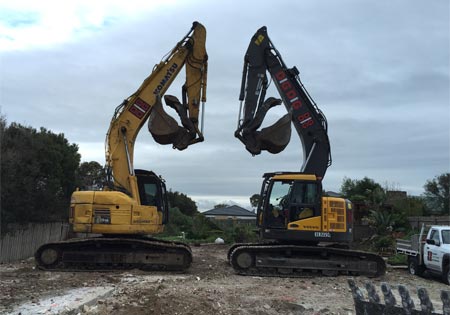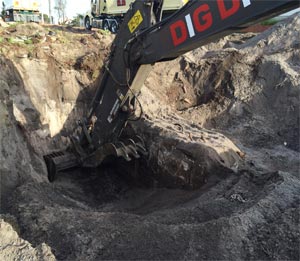
Quotes
Even if you love your current home, you know that there is always room for improvements. If you want to demolish an existing house, turn to Dig Dig for prompt, professional services.
Our family-owned and family-operated house demolition company in Melbourne can assist you with your current or upcoming demolition project. And because your demolition job is so unique from any other job, we'll provide you a free quote specific to your situation.
The best way for us to give you the most accurate quote for your project is for our experts to access the outside of your house, including the front and back yards. We'll walk throughout the site, noting any other structures like pools, sheds and landscaping features like gardens.
Then, we'll tell you what approach we think would be best for demolition and let you know a projected cost for the job.
Use the links to the right to learn more about our process and other things you should know. When you're ready to arrange a quote, call 0412 545 861 or email sales@digdigdemolition.com.

An Outline of the Process
Upon acceptance of the quote, we will issue our contract including a checklist of all the things required by you, the site owner to arrange as well as permission for us to organize the demolition permit. We will also require a 10% deposit which is used to apply for the Demolition (Building) Permit.
We will need a copy of the property title listing you as the owner of the property, if owned in a company name, a letter from the Company Director is required authorising Dig Dig Pty Ltd to act on their behalf to arrange the demolition permit.
If the property has only recently settled, a letter from your conveyancer detailing settlement dates and purchaser’s names is required.
We will need a site plan of the existing house. If the property has recently been surveyed to re-establish boundaries, this can be used. If not you can easily draw a diagram approximately to scale detailing the distance from boundaries of the building to be demolished, these are known as Set Backs. This should also document all buildings needing demolition, including building materials.
If there is a masonary wall, for example a garage wall on a boundary, a Form 3 & 4 Protection Work Notice will need to be obtained and given to neighbour who shares that wall. These forms can be obtained through us.
It is your responsibility to contact power and gas providers to arrange abolishment of these services. Please note, abolishment is not the same as simply disconnecting. This can take approximately 4 weeks, although in our experience we recommend contacting the gas and power companies a week after lodging abolishment applications to ensure paper work hasn’t been misplaced. Seriously it happens more than you’d think!
To save time it’s best to lodge both the gas and power abolishment applications at the same time.
If Telstra Cables are overhead, they will be cut by us on the day of demolition. However underground phone lines will require you to contact Telstra to be removed.
A Plumber is required to cap the sewer and the storm water points, we are happy to refer a fully qualified plumber if you need us to do so. Most Merchant Builder will require this to be done prior to taking over the site.
Providing there are no complications, it generally takes 3 to 4 weeks to obtain the required demolition permit.
Site fencing is mandatory on all building sites, once the property has been signed over for demolition it becomes a buidling site, it is no longer a house. Dig Dig Pty Ltd takes pride in being fully insured, however there is a clause in Demolition insurance that states; unless there is a fence with a minimum of no less than 1500mm high, restricting public access to the site, that any Public liability is void. This then leaves the site owner open to being sued. Site fencing is to be arranged by the site owner. If you need help with this, we are happy to refer companies.
All Councils will require the site owner to take out an Asset Protection Permit, this will need to be lodged by you, upon lodgement by Dig Dig of the Demolition Permit.
It is recommended you contact your local council regarding requirements pertaining to the removal of trees, this is your responsibility.
Upon abolishment of gas and power and issue of the Demolition Permit, you will need to return the Dig Dig Checklist, along with all relevant paperwork listed on the checklist. From this point the turn around of your demolition is approximately 4 weeks. So what happens next?
1 We will notify Worksafe of Asbestos removal, as per our licence we are required to give 5 working days notice prior to the removal of asbestos. When removal is complete, we will obtain a Clearance Certificate from an independent company which we then provide to you.
2 After the Asbestos removal, timber salvagers come in and strip the building of any re-usable timber. After this stage, the house looks like a bomb has exploded.
3 It is within a couple of weeks of the timber being stripped the machines move in and the building is demolished. This process can take a day to a few days depending on the size of the house, footings, extra buildings, pools, etc.
Upon completion of this stage the job site will be left bare corner to corner, it will be groomed and track rolled, with all neighbours trees and shrubs pruned back to the fence line to a height of 3000mm. It will be a blank slate, ready for your builders to commence.
Payment is required within 7 days of the completion of the job.
Things You Should Know

A section 29a or form B response from council, which is a Heritage Check, forms part of a Demolition (Building) Permit. It is not the Demolition Permit and a Demolition Permit cannot be obtained without the Heritage Check. Don’t be fooled by shonky operators who might leave you exposed to legal consequences.
There are plenty of Operators in the market performing demolition work without the necessary licences, this leave clients liable for fines for not using a licences contractor.
A Licensed Demolisher is required to obtain a Demolition Permit (Building Permit).
A Demolition Permit is required for all habitable structures, masonary structures and sheds over 60 square metres.
ASBESTOS will be found in all houses built prior to 1985.
It was used in the cement sheet found in the lining of eaves around the house, in kitchens and wet areas, for example, behind tiles in bathrooms, kitchens and laundries.
Externally asbestos was used in cement sheet cladding, faux brick and cement weatherboard cladding as well as Super 6 Roof Sheets.
Asbestos was phased out in 1985, however many people continued to use their remaining stockpiles, so for many houses built between 1985 and 1990 there is still the likelihood of asbestos being found.
Often house that have been renovated may unknowingly contain asbestos as they have been plastered over, without the asbestos being removed.
Asbestos can only be removed by a Licences Asbestos Removalist who is Registered with Worksafe. A Clearance Certificate upon completion of removal must be obtained by an independent operator and provided to the client. This is arranged by Dig Dig.
Asbestos can be found buried in the ground or under concrete slabs. Dig Dig cannot be aware of these situations, often they are not discovered until excavation begins, so therefore this will not be included in contracts. It will need to be requoted, based on the severity of the asbestos found.
If a house was built before 1985, has cement sheet material in it and hasn’t been renovated, you must ensure the Demolisher employed removes all asbestos and provides you with a clearance certificate prior to full demolition commencing.
You should get a copy of the Demolition Permit (Building Permit) and a Final Inspection Certificate.
